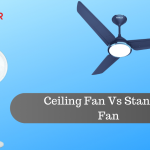A breeze is what keeps you cool. For times when there is no natural breeze, human beings resorted to use of a hand-held fan to keep cool. It is not precisely known who was the first inventor of the primitive device but progress shifted the fan from the hand to the ceiling. It is interesting to trace the history of ceiling fans back in time.
Far back in time
Today you can buy ceiling fans and enjoy a breeze at the touch of a button. The primitive ceiling fan dates back to 500 BC to India where it was not in the shape to day’s 3 bladed rotary fans but a piece of heavy cloth or board suspended from the ceiling and moved back and forth with the help of a cord. The Romans had something similar in that they used palm fronds suspended the ceilings and moved by human power. Around 4000 BC the Egyptians had servants using palm leaves to fan them. The Chinese can take credit for creating the human-powered mechanical fan in or around 180 AD. Around 1830 a doctor used blades to fan air over ice blocks to keep cool patients in his case.
Steam and turbine fans 1850s
Electricity was yet to make its way into appliances. Meanwhile, around the 1850s people came up with the idea of using steam or water turbine fans. A belt would link a network of fans that were used to keep interiors of large spaces cool. This system was in widespread use in the southern states of the USA. John and James Hunter, a father-son duo, built a water turbine powered ceiling fan in 1886 and some of their fans still survive though not in use. It is hardly likely you could buy ceiling fans in stores at that time.
Philip Diehl and Schuyler Skaats Wheeler
Philip Diehl, of German extraction, was a remarkable genius who invented the true ceiling fan that is the basis of the design of all modern fans in use today. Among other things, he held patents for electric lamps, sewing machine shuttle, electric motors for sewing machines and dynamos. He is credited with the invention of the ceiling fan in 1887, which design he patented in 1889. He mounted blades on a sewing machine motor and fixed it to the ceiling. Later on he added a ball joint and an oscillating mechanism. However, in real terms, Schuyler Skaats Wheeler was the person who placed a two-bladed propeller on the shaft of a motor in 1882 and created the electric fan for which he was awarded the John Scott Medal in 1904 by the Franklin Institute. Wheeler also invented the electric elevator and fire engine. Diehl build on his design and transplanted the fan to the ceiling.
Domestic use
It took just 20 years for ceiling fans to be commercialized and to be sold for domestic use. By 1910 people could buy ceiling fans and install them in their house. Robbins & Myers, Westinghouse Electric and Emerson Electric were the three companies manufacturing and selling fans in the US. The earliest fans operated on direct current but when alternating current came along, the fans became even more popular. Earlier models employed brushed motors with a heavy body but the rise of AC and induction brushless motor perfected by Crompton Parkinson of England. Weight reduction occurred with the use of a cast aluminium rotor and light aluminium blades and shell for the body. However, in comparison to modern fans you can buy today from Polycab Fan Dealers, those fans were very heavy and consumed more power.
The plain three bladed fan rules the roost today. Then there is a niche segment of decorative fans that includes a lamp in the middle and exotic design, even wood panelling for the blades. Electrical goods supplier in Ahmedabad can offer both the standard three bladed ceiling fan and decorative fans to suit luxurious interiors.




